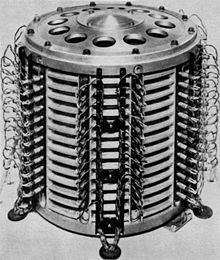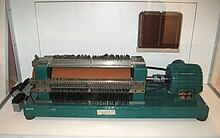
Back ذاكرة أسطوانية Arabic Memòria de tambor Catalan Bubnová magnetická paměť Czech Tromlelager Danish Trommelspeicher German Tambor magnético Spanish Trummelmälu Estonian طبله (رایانه) Persian Rumpumuisti Finnish Tambour (mémoire) French
| Computer memory and data storage types |
|---|
| Volatile |
| Non-volatile |


Drum memory was a magnetic data storage device invented by Gustav Tauschek in 1932 in Austria.[1][2] Drums were widely used in the 1950s and into the 1960s as computer memory.
Many early computers, called drum computers or drum machines, used drum memory as the main working memory of the computer.[3] Some drums were also used as secondary storage as for example various IBM drum storage drives and the UNIVAC FASTRAND series of drums.
Drums were displaced as primary computer memory by magnetic core memory, which offered a better balance of size, speed, cost, reliability and potential for further improvements.[4] Drums were then replaced by hard disk drives for secondary storage, which were both less expensive and offered denser storage. The manufacturing of drums ceased in the 1970s.
- ^ US Patent 2,080,100 Gustav Tauschek, Priority date August 2, 1932, subsequent filed as German Patent DE643803, "Elektromagnetischer Speicher für Zahlen und andere Angaben, besonders für Buchführungseinrichtungen" (Electromagnetic memory for numbers and other information, especially for accounting institutions)
- ^ Universität Klagenfurt (ed.). "Magnetic drum". Virtual Exhibitions in Informatics. Archived from the original on 14 April 2022. Retrieved 2011-08-21.
- ^ Datamation, September 1967, p.25, "For Bendix and Ramo-Wooldridge, the G-20 and RW-400 were parallel core machines rather than serial drum machines of the type already in their product lines."
- ^ Matick, Richard (1977). Computer Storage Systems & Technology. Wiley. p. 15.